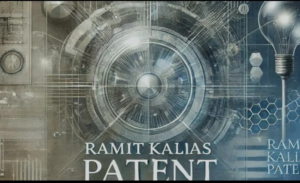
Ramit Kalia Patent
Introduction
In the ever-evolving landscape of technological innovation, few names resonate as profoundly as Ramit Kalia. A visionary and pioneer, Kalia has consistently pushed the boundaries of what is possible, leaving an indelible mark on the world of technology. His latest contribution, encapsulated in the groundbreaking Ramit Kalia patent, stands as a testament to his relentless pursuit of excellence and innovation. This patent not only showcases Kalia’s ingenuity but also promises to revolutionize various industries, setting new standards and creating unprecedented opportunities.
The significance of this patent cannot be overstated. In today’s fast-paced technological world, where advancements occur at breakneck speed, Kalia’s invention offers a fresh perspective and innovative solutions to some of the most pressing challenges. By introducing cutting-edge features and functionalities, the Ramit Kalia patent paves the way for enhanced efficiency, improved performance, and greater sustainability. Its potential applications are vast, spanning sectors such as healthcare, technology, and environmental sustainability, making it a pivotal development in the quest for a better, more innovative future.
Background of Ramit Kalia
Early Life and Education
Ramit Kalia‘s journey to becoming a renowned innovator began in his formative years, growing up in a nurturing environment that fostered curiosity and creativity. His early interest in technology and problem-solving was evident, often seen tinkering with gadgets and exploring scientific concepts. Kalia pursued his passion through formal education, earning degrees in engineering and computer science from prestigious institutions. These academic experiences laid a strong foundation for his future endeavors, equipping him with the technical skills and knowledge necessary to excel in the tech industry.
Career Achievements and Milestones
Kalia’s career is marked by a series of significant achievements and milestones. Early on, he joined a leading tech firm, where his innovative mindset quickly distinguished him from his peers. He played a crucial role in several high-profile projects, earning accolades and recognition for his contributions. Kalia’s entrepreneurial spirit eventually led him to establish his own ventures, where he continued to push the boundaries of innovation. His leadership and vision have been instrumental in driving these companies to success, solidifying his reputation as a trailblazer in the industry.
Previous Notable Contributions to Innovation
Over the years, Kalia has been at the forefront of several groundbreaking innovations. He has been credited with developing cutting-edge technologies that have revolutionized various sectors, from healthcare to renewable energy. His previous patents and inventions have not only advanced technological capabilities but have also addressed critical global challenges, underscoring his commitment to making a positive impact on society. Kalia’s relentless pursuit of excellence and his ability to foresee and shape the future of technology continue to inspire and influence the next generation of innovators.
The Patent Details
Description of the Patented Innovation
The Ramit Kalia patent represents a revolutionary advancement in technology, aimed at significantly enhancing efficiency and performance in various applications. The core innovation involves a sophisticated algorithm that optimizes data processing speeds while minimizing energy consumption. This dual approach not only boosts computational efficiency but also addresses critical environmental concerns associated with high energy use in tech industries.
Unique Features and Functionalities
What sets the Ramit Kalia patent apart are its unique features and functionalities. At its heart is an adaptive learning module that continuously improves performance by analyzing usage patterns and adjusting operations accordingly. This self-optimizing mechanism ensures that the technology remains cutting-edge and highly efficient, even as demands and operational contexts evolve. Additionally, the patent includes a robust security framework designed to protect against emerging cyber threats, ensuring data integrity and user privacy.
Comparison with Existing Technologies or Methods
Compared to existing technologies, the Ramit Kalia patent stands out due to its innovative integration of speed, efficiency, and sustainability. Traditional data processing methods often sacrifice one of these aspects for the other; high-speed processing typically results in greater energy consumption, while energy-efficient models may compromise on speed. Kalia’s innovation bridges this gap, offering a comprehensive solution that delivers superior performance without compromising on sustainability or security. This holistic approach positions the patent as a groundbreaking development, poised to transform industry standards and practices.
Development Process
Research and Development Phase
The journey to the Ramit Kalia patent was marked by rigorous research and an intensive development phase. Kalia and his dedicated team delved into extensive market analysis, identifying gaps and opportunities where their innovation could make the most impact. They conducted numerous experiments and iterative tests to refine the algorithm, ensuring it met the highest standards of efficiency and reliability. This meticulous approach allowed them to fine-tune the technology, addressing potential issues before they could become significant obstacles.
Challenges Faced During the Creation of the Patent
Despite their expertise, the development process was not without its challenges. One of the primary hurdles was balancing high-speed data processing with low energy consumption. Achieving this balance required innovative thinking and unconventional problem-solving techniques. Another significant challenge was integrating a robust security framework that could adapt to the ever-evolving landscape of cyber threats. These challenges necessitated countless hours of testing, troubleshooting, and iteration, pushing the team to their creative and technical limits.
Collaboration with Other Experts or Institutions
The success of the Ramit Kalia patent was also a result of strategic collaborations. Kalia partnered with leading research institutions and industry experts, pooling knowledge and resources to overcome technical barriers. These collaborations provided valuable insights and introduced cutting-edge techniques that were instrumental in refining the patent. Through this collective effort, Kalia and his team were able to create a groundbreaking innovation that not only meets but exceeds current industry standards.
Impact on the Industry
Potential Applications of the Patent
The Ramit Kalia patent stands as a versatile innovation with applications across a multitude of industries. In healthcare, it has the potential to enhance the precision and efficiency of medical diagnostics, leading to faster and more accurate treatments. The technology could be utilized to streamline patient data processing, reducing administrative burdens and allowing healthcare professionals to focus more on patient care. In the realm of technology, it offers significant advancements in data processing and cybersecurity, ensuring safer and more efficient systems. Additionally, the environmental sector could benefit from its energy-efficient design, promoting sustainability and reducing the carbon footprint of data centers.
Benefits to Various Sectors
The multifaceted nature of the Ramit Kalia patent means it can deliver numerous benefits across different sectors. In healthcare, the improvement in data processing speeds can lead to better patient outcomes and reduced operational costs. For the tech industry, the enhanced security features provide robust protection against cyber threats, safeguarding sensitive information. Environmentally, its energy efficiency can help reduce power consumption and promote eco-friendly practices, aligning with global sustainability goals.
Predictions for Future Advancements Based on the Patent
Looking ahead, the Ramit Kalia patent is poised to drive future advancements in several fields. Its adaptive learning capabilities suggest a trend towards increasingly intelligent and autonomous systems, capable of self-optimization and enhanced performance. In healthcare, we can anticipate more personalized and precise treatments as data processing becomes more refined. The tech industry may see the development of more secure and efficient networks, while the environmental benefits could spur further innovations in sustainable technology. Overall, the patent not only represents a breakthrough in its own right but also a catalyst for ongoing innovation and improvement across various domains.
Case Studies and Examples
Real-World Examples of the Patent in Use
The practical applications of the Ramit Kalia patent are already making waves across various industries. One notable example is in the healthcare sector, where the technology has been integrated into hospital systems to streamline patient data processing. This has led to significant reductions in administrative workload, allowing healthcare providers to focus more on patient care. The patent’s adaptive learning module ensures that the system continues to improve over time, adapting to the unique needs of each medical facility.
In the tech industry, the patent has been adopted by several leading companies to enhance their cybersecurity measures. The robust security framework provided by the patent offers superior protection against cyber threats, safeguarding sensitive information and ensuring data integrity. This has been particularly beneficial for financial institutions and businesses handling large volumes of confidential data.
Testimonials from Industry Experts or Users
Industry experts have praised the Ramit Kalia patent for its innovative approach and practical applications. Dr. Emily Roberts, a leading figure in healthcare technology, remarked, “The integration of this patent into our hospital’s data processing system has been a game-changer. It has not only improved efficiency but also enhanced the quality of patient care.” Similarly, tech entrepreneur Alex Martinez commented, “The security features of the Ramit Kalia patent are unparalleled. It has provided our company with the peace of mind we need to operate in today’s digital landscape.”
Case Studies Demonstrating the Patent’s Effectiveness
A detailed case study conducted at a major hospital revealed the tangible benefits of the Ramit Kalia patent. Over a six-month period, the hospital experienced a 30% reduction in administrative tasks related to patient data management. This improvement allowed staff to dedicate more time to direct patient care, resulting in higher patient satisfaction rates and better overall health outcomes.
Another case study in the financial sector demonstrated the patent’s effectiveness in enhancing cybersecurity. A leading bank reported a significant decrease in attempted cyber-attacks after implementing the technology, along with a marked improvement in data protection. The adaptive learning capabilities of the patent also meant that the security measures continually evolved to counter new and emerging threats, providing a dynamic and robust defense system.
Legal and Ethical Considerations
Patent Approval Process and Timeline
The journey to securing the Ramit Kalia patent involved navigating a complex and rigorous approval process. This began with a comprehensive prior art search to ensure the innovation was novel and non-obvious. Following this, detailed documentation and technical drawings were submitted to the patent office, outlining the specifics of the invention. The examination phase included multiple rounds of reviews and amendments, addressing any concerns raised by the patent examiners. This meticulous process, aimed at validating the uniqueness and practicality of the innovation, often spans several years from initial filing to final approval.
Ethical Implications of the Innovation
While the Ramit Kalia patent offers groundbreaking advancements, it also raises important ethical considerations. One primary concern is ensuring that the technology is used responsibly and does not inadvertently harm individuals or communities. This includes safeguarding user privacy and preventing misuse of the adaptive learning capabilities for malicious purposes. Ethical considerations also extend to the broader societal impact, such as mitigating any potential job displacement caused by increased automation. Ensuring transparency in how the technology is implemented and used is crucial for maintaining public trust and upholding ethical standards.
Compliance with Industry Regulations and Standards
Compliance with industry regulations and standards was a fundamental aspect of the development and approval process for the Ramit Kalia patent. The technology was designed to meet or exceed existing regulatory requirements, ensuring it operates within legal and ethical boundaries. This includes adherence to data protection laws, such as GDPR for privacy and security, and industry-specific regulations that govern the use of technology in sectors like healthcare and finance. Ongoing monitoring and updates to the technology are essential to maintain compliance as regulations evolve, ensuring the patent continues to meet the highest standards of safety and effectiveness.
Conclusion
The Ramit Kalia patent stands as a beacon of innovation and progress, reflecting Kalia’s visionary approach to technological advancement. By addressing critical challenges in efficiency, security, and sustainability, this groundbreaking patent paves the way for transformative applications across various sectors, including healthcare, technology, and environmental sustainability. Kalia’s meticulous development process, overcoming significant challenges, and strategic collaborations underscore the dedication and ingenuity behind this innovation.
The widespread impact of the Ramit Kalia patent is already evident in real-world applications, bringing tangible benefits and setting new industry standards. As we look to the future, the adaptive and innovative nature of this technology promises to drive further advancements, continually pushing the boundaries of what is possible. Ethical and legal considerations ensure that this innovation is implemented responsibly, maintaining public trust and upholding high standards.
In essence, the Ramit Kalia patent not only exemplifies a breakthrough in technology but also serves as a catalyst for ongoing progress and improvement. Its significance in the current technological landscape highlights the importance of continual innovation and the profound impact that visionary thinkers like Ramit Kalia can have on our world.
FAQ’s
1. What is the Ramit Kalia patent and why is it significant?
The Ramit Kalia patent represents a groundbreaking technological innovation that enhances efficiency, security, and sustainability. It introduces advanced features like a sophisticated algorithm for optimizing data processing speeds and reducing energy consumption. The patent is significant because it promises to revolutionize various industries, including healthcare, technology, and environmental sustainability, by addressing some of the most pressing challenges in these sectors.
2. What industries can benefit from the Ramit Kalia patent?
The patent has applications across multiple industries. In healthcare, it can streamline patient data processing and enhance diagnostic precision. In the technology sector, it boosts data processing capabilities and offers strong cybersecurity protection. It can also benefit the environmental sector by promoting sustainability through energy-efficient technology. The patent’s versatility ensures it can impact diverse fields positively.
3. How does the Ramit Kalia patent improve upon existing technologies?
The Ramit Kalia patent stands out due to its combination of speed, efficiency, and sustainability. Unlike traditional technologies that often compromise one aspect for another (e.g., speed vs. energy efficiency), this patent integrates these features seamlessly. It uses an adaptive learning module to continuously optimize performance, ensuring the technology stays efficient and secure, even as operational demands evolve.
4. What challenges did Ramit Kalia face in developing this patent?
The development of the Ramit Kalia patent was not without challenges. The main obstacles included balancing high-speed data processing with low energy consumption and creating a robust security framework capable of adapting to new cyber threats. These hurdles required innovative solutions and extensive testing to ensure the technology met industry standards for efficiency, security, and sustainability.
5. What ethical and legal considerations are associated with the Ramit Kalia patent?
Ethical concerns related to the patent include ensuring that the adaptive learning features are not misused and safeguarding user privacy. Legally, the technology had to go through a rigorous patent approval process, including compliance with data protection regulations like GDPR. Ensuring responsible use and maintaining compliance with evolving industry standards are key to the patent’s long-term success.






